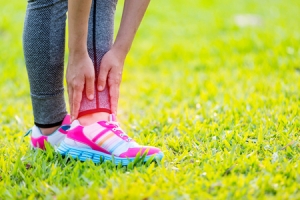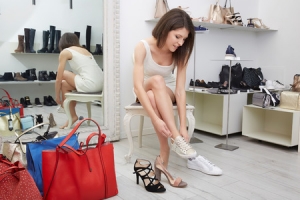Connect With Us
Blogs
Displaying items by tag: shin splints
Foot Disorders that Sound Scary (but Aren’t!)
At Superior Foot & Ankle Care Center we thought we’d get into the spirit of Halloween for our Los Angeles County patients by exploring some foot problems that have frightening names. If our podiatrists, Dr. Victoria M. Foley and Dr. Constance Ornelas told you that you had one of the disorders named below, you might panic. But in reality, these are just the medical names for some fairly common and easily treatable conditions. And, our friendly podiatrists would most likely tell you the “user-friendly” name of your foot problem to avoid alarming you!
Tinea Pedis—You’d probably be less scared if you heard “athlete’s foot,” the common name for this itchy skin problem. Often beginning between your toes, the skin will be red, itchy, and flaky. In advanced cases, oozing blisters and cracks in the skin may develop. There are a number of topical treatments that the foot doctor may prescribe to eliminate athlete’s foot. Of course, it’s better to avoid contracting it in the first place. To prevent athlete’s foot, wear shower shoes when walking in public places like community pools and gyms, avoid items that touch another person’s foot, and keep feet dry.
Medial Tibial Stress Syndrome—You may experience this podiatric problem if you’ve recently started a new walking or running program. Its shorter name is “shin splints.” Telltale signs include pain, swelling, and tenderness in the front of the leg on either side of the shin bones. It’s important that you have your legs and feet examined by the foot doctor if you have shin splints because there are a number of different causes of this condition. Left untreated, the pain will get worse and may even lead to a stress fracture.
Onychomycosis—What does it mean when your toenails become discolored and get thick and crumbly? Most likely you’ve contracted toenail fungus—also known as onychomycosis. Fungal toenails are harder to get rid of than other fungal infections. The foot doctor will prescribe the best treatment option for you. We also offer KeryFlex Nail Restoration System to repair nails damaged by fungal infections.
We don’t ever want any of our patients to be fearful about seeing the podiatrist. If you notice anything that looks even a little frightful about your toes, feet or ankles make an appointment at our Long Beach office today by calling: (562) 420-9800.
Do’s and Don’ts for Getting Your Child Ready for Spring Sports
It’s time for another sports season and we at Superior Foot & Ankle Care Center want to ensure that your child gets a safe start. Below are some do’s and don’ts to help prepare young athletes to have a successful and injury-free season.
Do: start by making sure your child’s feet and ankles are in tiptop shape. Get any lower extremity pain or discomfort checked by our podiatrists, Dr. Victoria Foley and Dr. Constance Ornelas. In addition to assessing the health of your child’s feet, the foot doctor will also revisit the site of any previous trauma to be sure there is no risk for re-injury.
Do: ask the foot doctor about any accommodations necessary for chronic conditions such as plantar fasciitis or weak ankles. The foot doctor may recommend specific shoe styles or a custom orthotic device for your child.
Don’t: allow your child to go from zero to sixty on the physical activity scale. Many injuries, like Achilles tendonitis and shin splints, occur when children go directly from a period of inactivity to intense workouts.
Do: ask the coach a few weeks before the season starts to provide you with stretching and conditioning exercises and suggestions for how your child can gradually build up strength and stamina for their sport.
Do: get the right shoes for the sport your child will be participating in. This may be the single, biggest step you can take to prevent sports injuries. Get feet measured professionally and choose shoes that offer the proper support for ankles and arches.
Don’t: allow your children to wear passed on sports shoes. Shoes do conform to the shape and gait of the person who wears them. Putting your child in someone else’s shoes may do harm to their feet.
Do: check the conditions of the field, track or other surfaces where your child’s practices and games will take place. Speak up if you notice cracked pavement, uneven playing surfaces or fields that have many holes and divets. These can all lead to podiatric and other injuries.
Don’t: hesitate to contact our Long Beach office if your child experiences pain or discomfort in their lower extremities as the season progresses.
Common Reasons Exercise Programs Fail
At Superior Foot & Ankle Care Center we know the importance of exercise to your feet as well as the rest of your body. That’s why we applaud patients who make a resolution to get in shape in the New Year. Too often, however, by the time February rolls around many exercise plans have already been shelved. Below are some scenarios that can bring fitness plans to a halt and how to work around them.
“Let’s do this! I am going to work out every day to get in shape fast no matter what it takes.”
Not so fast, or you’ll likely end up with an injury. Achilles tendonitis, ankle sprains, and shin splints are just a few of the conditions that can be caused by doing too much too quickly. Not to mention that an overly ambitious start, especially if you’re out of shape, can lead to fatigue and discouragement before you even really get started. The best bet for long-term success is to do an activity or program that allows you to start slowly and gradually increase the level of your workout.
“I started a running program a few years ago and still have my shoes—yay! I won’t have to go out and buy new ones.”
Footwear is one of the most important factors in the success of an exercise program. Getting fitness shoes that are designed for the sport or activity, you’ll be doing is key. However, foot size can change over time. It’s best to get your foot measured professionally and try your shoes on to make sure they are still comfortable.
“I have a bunion, but I think if I put a pad over it I should be able to exercise without a problem.”
Before starting a new exercise program, it’s always best to consult your general practitioner and also your podiatrist. Our foot doctors, Dr. Victoria Foley or Dr. Constance Ornelas, will examine your feet completely. If you have a chronic foot problem, the podiatrist can recommend shoe styles and make suggestions for how to best accommodate your condition. In some cases, a custom orthotic device can increase comfort and performance.
“I’m going to join a gym—there are lots of good deals available now.”
Take the time to consider your likes and lifestyle. A gym is a good option if you like the classes and machines offered and you need to schedule around your work. Consider if you want a more social setting or if you like to work out alone, if you prefer an indoor or outdoor activity and how much time you can devote to your fitness plan. You’re more likely to stick to a plan that suits your interests and your availability.
If you experience any foot or ankle pain or discomfort when exercising, contact our Long Beach office by calling: (562) 420-9800.
3 Foot Care Tips for Getting in Shape
If you are like many of our patients at Superior Foot & Ankle Care Center the New Year is a time to renew your commitment to getting physically fit. This is a worthy resolution that will benefit your feet and your entire body. Improved circulation, maintaining a healthy weight, decreased risk of heart disease and high blood pressure and stress relief are among the many benefits of regular exercise. Before you get started, however, we’d like to make the following suggestions to protect your feet and increase the enjoyment of your fitness program.
Get a Checkup—it’s a good idea to meet with our podiatrists, Dr. Victoria Foley and Dr. Constance Omelas and discuss your fitness goals and how you hope to achieve them. Some exercises put more stress on your feet than others. It’s important to have a complete examination of your feet and ankles and to have the foot doctor address any ongoing problems that you may be having. Sometimes special orthotics or padding may be recommended to protect a vulnerable area and make exercise more comfortable. The foot doctor can also make specific recommendations regarding shoes that suit your gait and foot.
Shop for Shoes—if you are going to be trying out a new activity go to a professional sports shoe store to get the correct footwear for your sport. Sports shoes are designed specifically for the types of movement required for specific activities. You should have your foot measured and also let the shoe salesperson know about any foot issues you have. You can avoid blisters by wearing shoes that are the correct size and don’t rub anywhere on your foot. Be sure to pick up some absorbent socks as well. Keeping feet dry is essential to avoid athlete’s foot and other fungal infections from developing.
Don’t Skip the Conditioning—properly warming up and stretching the ligaments, tendons and muscles in your lower legs and feet before and after exercise can help you avoid common injuries such as shin splints, Achilles tendonitis and plantar fasciitis.
If after you begin an exercise routine you notice pain in your toes, feet, ankles, calves or shins, be sure to make an appointment at our Long Beach office by calling: 562-420-9800. Continuing to work out while you are in pain will cause way more harm than good.
Resolve to Walk in the New Year
If getting in shape is one of your New Year’s resolutions, we at Superior Foot & Ankle Center would like to encourage you to consider walking. Walking is a very effective exercise, particularly if you have been inactive in the recent past. Consider these benefits:
- Can be done all year round outdoors (especially with our beautiful Long Beach weather) or indoors on a treadmill
- Walking is an activity that can be enjoyed alone or with others
- Walking lowers blood pressure, blood sugar and cholesterol while also providing a cardiovascular workout, improved circulation, stress relief and weight loss
- No special equipment is needed (except a good pair of walking shoes)
Of course walking can cause problems as well. Blisters, corns and calluses, plantar fasciitis, shin splints, and Achilles tendonitis are all potential conditions that can occur as a result of walking. You can help prevent these problems from developing, however, by following a few simple tips:
- Make an appointment for a podiatric check up before starting your new walking routine. Our board certified foot and ankle surgeons, Dr. Victoria Foley and Dr. Constance Omelas will examine your toes, feet and ankles and determine if there are any pre-existing problems that need to be treated. The foot doctor can also analyze your gait and see if you tend toward over-pronation, which may affect your shoe choice.
- Choose a sensible walking program that starts out slow and gradually increases distance and intensity.
- Always remember to stretch before and after you walk.
- Invest in good walking shoes and get professionally fitted at a sports or fitness store.
A little soreness or stiffness when you start a new fitness routine is normal but if you find you are experiencing ongoing pain or any swelling or other unusual symptoms contact our Long Beach office by calling: 562-420-9800.





